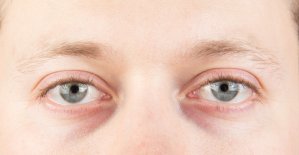Omega-3 supplements are effective for dry eyes
 According to a study from Ohio State University, Columbus, USA, people suffering from dry eyes may find relief by consuming more oily fish or taking a fish oil supplement.
According to a study from Ohio State University, Columbus, USA, people suffering from dry eyes may find relief by consuming more oily fish or taking a fish oil supplement.
Our risk of getting dry eyes increases as we age, and the condition is rather common. Symptoms include a sensation of dryness or sand in the eyes combined with a stinging and burning feeling that is especially noticeable during the daytime. Transient blurry vision and slightly red eyes may also occur. Having dry eyes can get in the way of basic activities such as reading or using contact lenses, and the condition is also known to lower one’s tolerance towards tobacco smoke, dry air, and air conditioners.
Although fish oil is already standard therapy for the treatment of dry eyes in the United States, only few studies are actually able to account for the exact effect of various types of omega-3
Why is our tear production to vital?
Tears are produced by the small tear canals that are located under the upper eyelids facing the ear. When we blink, this fluid lubricates the surface of the eye, thereby protecting our eyes against disease.
Tears consist of three layers: The outer lipid layer, the middle aqueous layer, and the inner slimy layer. Underneath the tears is the eye surface with slimy substances that help the tears stick to the surface. The tears dissipate via a small drain hole in each lower eyelid close to the base of the nose, or through evaporation, and overflow from the lower eyelids.
When and why do dry eyes occur?
Dry eyes occur as a result of reduced tear production or when tears evaporate too quickly. Dry eyes may also be accompanied by local inflammation of the eye surface. In the majority of cases, dry eyes are not a sign of underlying disease but merely insufficient tear production in the course of the day. Dry eyes may also occur as an acute or chronic condition caused by several things such as:
- the ageing process
- reduced blinking frequency (e.g. when sitting in front of the computer)
- dry or polluted air
- pregnancy or menopause
- birth control pills and estrogen therapy (estradiol)
- damaged cornea and laser treatment
- eye allergies and certain autoimmune diseases (Sjogren’s syndrome, LED, and rheumatoid arthritis)
- prolonged use of contact lenses
- protruding eye balls and insufficient eye lid coverage during sleep
- lack of nutrients – including vitamin A and omega-3
How omega-3 fatty acids help against dry eyes
Omega-3 fatty acids belong to a group of poly-unsaturated fatty acids that are found in all cell membranes and take part in numerous biochemical processes.
The omega-3 fatty acids, EPA and DHA, increase levels of fatty acids in the tear gland and its secretions. EPA and DHA are both poly-unsaturated and particularly long-chained fatty acids that remain fluid at room temperature. This rather important feature prevents the tear canal from being blocked. At the same time, the inner layer of the tears is supplied with the necessary lipids, which helps keep the eyes moist and prevents untimely tear evaporation. Omega-3 fatty acids even contribute to the protection of the local nerve paths, and EPA specifically counteracts inflammation that typically occurs as a result of local irritation of injuries.
Consumption of oily fish and supplements according to the new study
The omega-3 fatty acids, EPA and DHA, are found in oily fish and fish oil supplements. The new study from Ohio State University was a so-called retrospective study of 32,470 women and showed that those who consumed at least six portions of tuna weekly were 66% less likely to be diagnosed with dry eyes, compared with those who consumed less tuna. The study, which is conducted by Dr. Epitropoulos and his colleagues, is published in the science journal Corona.
As many people never consume oily fish or only eat very little, more and more American doctors recommend fish oil supplements.
Dr. Epitropoulos suggests that the quality of the fish oil supplement, including its chemical form and the way it is derived, may influence its effect on patients with dry eyes and other conditions that are caused by a lack of omega-3 fatty acids.
Be aware of the different form of fish oils in fish and supplements
Most fat in our diet comes as triglycerides, even the healthy omega-3 fatty acids in fish. However, the manufacturing and cleansing of fish oils is associated with various costs, if the intention is to keep the fish oil in its original triglyceride form. On the other hand, fish oil based on triglycerides is more stable and provides better bioavailability than fish oil based on ethyl esters. Humans can only benefit from fish oil when it is absorbed properly, so quality comes before quantity. Always make sure to study the label. Some fish oils come in the form of free fatty acids, which the digestive system can absorb directly because the fatty acids have already been broken down. They provide faster and more complete absorption in the body
References
Re-esterified Omega-3 Supplements Effective in Dry Eye
http://www.medscape.com/viewarticle/879826
Omega3 / dry eye
https://www.ncbi.nlm.nih.gov/m/pubmed/?term=omega+3+dry+eye
Omega-3 essential fatty acids may protect corneal nerves in dry eye
https://medicalxpress.com/news/2017-03-omega-essential-fatty-acids-corneal.html
From Alpha to Omega: How Fatty Acids Fight Dry Eye
https://www.reviewofoptometry.com/article/from-alpha-to-omega-how-fatty-acids-fight-dry-eye
https://www.netdoktor.dk/ojne/torre_ojne.htm
Search for more information...
- Created on .








